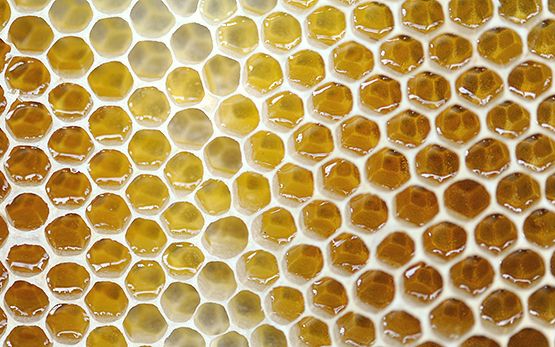Der Wassergehalt des von den Pflanzen produzierten Nektars kann variieren. Um seine Konservierung in den Waben zu gewährleisten, darf er nicht gären. Deshalb wird er von den Bienen in Honig umgewandelt, indem sie seinen Wassergehalt senken und folglich den Zuckergehalt erhöhen. Dies verhindert die Entwicklung der Mikroorganismen. In der Dunkelheit des Bienenstocks ist es schwierig, den Herstellungsprozess des Honigs zu beobachten. Aus diesem Grund ist er auch nur wenig erforscht. Um die Umwandlung von Nektar in Honig zu untersuchen, haben wir die Technik der Tomographie eingesetzt. Sie ermöglicht es, den Zuckergehalt des eingelagerten Nektars sehr präzise zu messen, ohne den Bienenstock öffnen zu müssen und das Bienenvolk zu stören.

Publications Thomas Bucheli
Hilber I., Bahena‑Juárez F., Chiaia‑Hernández A.C., Elgueta S., Escobar‑Medina A., Friedrich K., González‑Curbelo M.A., Grob Y., Martín‑Fleitas M., Miglioranza K.S.B., Peña‑Suárez B., Pérez‑Consuegra N., Ramírez‑Muñoz F., Sosa‑Pacheco D., Bucheli T.
Pesticides in soil, groundwater and food in Latin America as part of one health.
Environmental Science and Pollution Research, 31, 2024, 14333-14345.
Bucheli T., Barmettler E., Bartolome N., Hilber I., Hornák K., Meuli R. G., Reininger V., Riedo J., Rösch A., Sutter P., van der Heijden M., Wächter D., Walder F.
Pesticides in agricultural soils: Major findings from various monitoring campaigns in Switzerland.
Chimia, 77, (11), 2023, 750-757.
Wettstein F., Sutter P., Bucheli T.
Analysis of pesticides in soil: Observations from one year routine.
In: 5th Swiss Pesticide Residue Workshop. 22 November, Pratteln. 2023, 1-24.
Rösch A., Wettstein F., Wächter D., Reininger V., Meuli R. G., Bucheli T.
A multi‑residue method for trace analysis of pesticides in soils with special emphasis on rigorous quality control.
Analytical and Bioanalytical Chemistry, 415, (24), 2023, 6009-6025.
Riedo J., Wächter D., Gubler A., Wettstein F., Meuli R. G., Bucheli T.
Pesticide residues in agricultural soils in light of their on-farm application history.
Environmental Pollution, 331, 2023, 1-8.
Rathnayake D., Schmidt H.-P., Leifeld J., Mayer J., Epper C., Bucheli T., Hagemann N.
Biochar from animal manure: A critical assessment on technical feasibility, economic viability, and ecological impact.
Global Change Biology Bioenergy, 15, (9), 2023, 1078-1104.
Bucheli T., Hilber Schöb I., Schmidt H.-P., Hagemann N.
Polyzyklische aromatische Kohlenwasserstoffe (PAK) in Pflanzenkohle: Früher unbekannt – heute bestbekannt.
In: Pflanzenkohle-Fachtagung 2023. 16. Juni, Publ. Charnet – Schweizer Fachverband für Pflanzenkohle, Brugg-Windisch. 2023.
Riedo J., Yokota A., Walther B., Bartolomé N., van der Heijden M., Bucheli T., Walder F.
Temporal dynamics of total and bioavailable fungicide concentrations in soil and their effect upon nine soil microbial markers.
Science of the Total Environment, 878, 2023, 1-10.
Hagemann N., Conte P., Leifeld J., Giger R., Bucheli T., Schmidt H.-P., Grafmüller J.
Impact of biomass ash content on biochar carbon speciation and stability.
In: EGU General Assembly 2023. 25 April, Publ. European Geosciences Union (EGU), Vienna (AT). 2023, 1.
Sigmund G., Schmid A., Schmidt H.-P., Hagemann N., Bucheli T., Hofmann T.
Sometimes size matters – new insights into the physical disintegration of biochar.
In: EGU General Assembly 2023. 28 April, Publ. European Geosciences Union (EGU), Vienna (AT). 2023, 1.
Liang X., Christensen J. H., Bucheli T., Nielsen N. J.
Suspect screening of lupin-produced phytotoxins in environmental samples.
LCGC Europe, 36, (5), 2023, 158-162.
Liang X., Christensen J. H., Bucheli T., Juul Nielsen N.
Source-supported suspect screening (4S) of phytotoxins in terrestrial and aquatic environments: A field study of Lupinus angustifolius L. (Blue Lupin).
Environmental Science & Technology, 57, (6), 2023, 2333-2340.
Sigmund G., Schmid A., Schmidt H.P., Hagemann N., Bucheli T., Hofmann T.
Small biochar particles hardly disintegrate under cryo-stress.
Geoderma, 430, 2023, 1-6.
Walder F., Schmid M. W., Riedo J., Valzano A., Banerjee S., Büchi L., Bucheli T., van der Heijden M.
Soil microbiome signatures are associated with pesticide residues in arable landscapes.
Soil Biology and Biochemistry, 174, 2022, 1-12.
Chiaia-Hernandez A.C., Casado-Martinez C., Lara-Martin P., Bucheli T.
Sediments: sink, archive, and source of contaminants.
Environmental Science and Pollution Research, 29, 2022, 85761-85765.
Riedo J., Herzog C., Banerjee S., Fenner K., Walder F., van der Heijden M., Bucheli T.
Concerted evaluation of pesticides in soils of extensive grassland sites and organic and conventional vegetable fields facilitates the identification of major input processes.
Environmental Science & Technology, 56, (19), 2022, 13686-13695.
Hilber Schöb I., Blum F., Schmidt H.P., Bucheli T.
Current analytical methods to quantify PAHs in activated carbon and vegetable carbon (E153) are not fit for purpose.
Environmental Pollution, 309, 2022, 1-8.
Grafmüller J., Böhm A., Zhuang Y., Spahr S., Müller P., Otto T. N., Bucheli T., Leifeld J., Giger R., Tobler M., Schmidt H. P., Dahmen N., Hagemann N.
Wood ash as an additive in biomass pyrolysis: Effects on biochar yield, properties, and agricultural performance.
ACS Sustainable Chemistry & Engineering, 10, (8), 2022, 2720-2729.
Sosa D., Hilber Schöb I., Bürge D., Faure R., Escobar A., Bucheli T.
Heavy metals in soils of Mayabeque, Cuba: multifaceted and hardly discernable contributions from pedogenic and anthropogenic sources.
Environmental Monitoring and Assessment, 194, 2022, 1-17.
Philipp M., Bucheli T., Kaegi R.
The use of surrogate standards as a QA/QC tool for routine analysis of microplastics in sewage sludge.
Science of the Total Environment, 835, (155485), 2022, 1-9.





